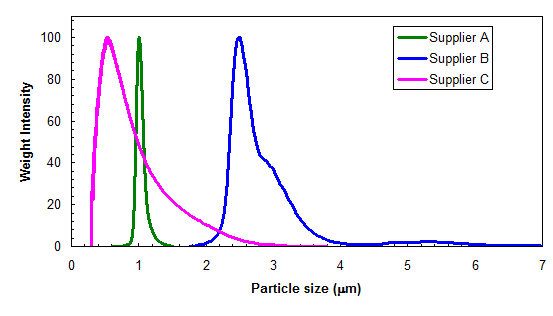In order to ensure the success of a protocol, it is essential to have a clear and unbiased knowledge base and a reliable source of reference material. When trying to decide the best platform or application to use for a process, it is critical to ensure that the information on which the decision will be based is generic and factual, and not propagated as promotional data.
The use of magnetic particles in protein purification processes presents many benefits compared to classical procedures, being process simplicity and time saving the most relevant. These benefits are highly detailed in our protein purification handbook. There are many factors and variables that can potentially influence the success of the process. However the properties of the magnetic particles to be used, in addition to the magnetic equipment used for the separation, stand out among them.
It is known that the mean particle size of the magnetic beads mostly governs the purification process. This is because the lower the mean particle size the higher the surface available for protein binding. However, increasing the particle size gives higher magnetic forces and therefore reduces the process. In that sense, there is a compromise between binding capacity and process time.
In order to fulfill the different necessities, magnetic particle suppliers usually offer magnetic dispersions with different mean particle sizes. However, there is another variable that has not had as much attention as the main particle size and in fact can highly affect the behavior of the process: the particle size distribution (PSD). Well known and reported conditions of non-magnetic particle synthesis allow the production of highly monodisperse dispersions with very low variance in particle size. However, the incorporation of an inorganic compound in order to manufacture the magnetic dispersions complicates the production process, and broadening of the PSD is not easy to avoid.
In protein purification it is mandatory to obtain a strict control of the protein binding to magnetic particles in order to obtain satisfactory and reproducible results. For this reason the use of magnetic particles with broad PSD is a focus of variability that affects negatively to the process. The use of magnetic particles with broad PSD gives differences in the amount of ligand incorporated and in the separation speed, which affect directly in the protein purification yield. This variability is critical in screening processes (where small amounts of product are used), but also in industrial scale where a robust lot-to-lot and intralot reproducibility is essential. Besides, this variability can be especially important if the proper magnetic separation equipment is not used.
This lack of attention to the PSD from some manufacturers could be related to the difficulty for a proper characterization of the magnetic dispersions. For example, the PSDs obtained by dynamic light scattering differ from real ones when broad or multimodal samples are measured, mainly above micron scale. In addition, using imaging characterization techniques like transmission or scanning electron microscopes it is really difficult to distinguish between aggregated particles and aggregates formed during the drying step of the sample.
In contrast to the above mentioned techniques, Disc Centrifuge Photosedimentation has been validated as a really powerful technique for a proper PSD characterization. In this technique, particles of different sizes are allowed to reach a photodetector at different times due to the centrifugal force. In this way, the PSD and the number (Dn) and weight (Dw) average particle sizes are obtained. In order to quantify the monodispersity of the PSD, Polidispersity Index (PDI) is defined as the ratio between Dw and Dn, and dispersions with values less than 1.05 are considered monodisperse.
In the figure, the PSDs of 3 commercially available magnetic dispersions are shown.

The table below shows the data corresponding to these distributions:
|
Dn (um) |
Dw (um) |
PDI |
|
|
Supplier A |
1.021 |
1.037 |
1.02 |
|
Supplier B |
2.888 |
2647 |
1.09 |
|
Supplier C |
0.519 |
0.949 |
1.83 |
Attending to these results, it is clear that monodispersity is not always guaranteed when purchasing magnetic dispersions.
Summarizing, we can say that the PSD of magnetic dispersions is a parameter that can highly influence the success of protein purification processes. For this reason it is strongly recommended to assure the supply of magnetic dispersions with narrow PSD.
You will find this post and many more interesting articles about using biomagnetic separation for protein purification in our Advanced Guide to Biomagnetic Protein Purification:
This article is part of a teamwork of IKERLAT’s R&D department formed by Dr. Joxe Sarobe, Dr. Pedro Ilundain, Dr. Sergio Rubio and Dr. Asier Eleta.
Related articles:
- Advantages of Magnetic Agarose in Protein Purification
- Key benefits of Magnetic Sepharose beads
- Novel Hyper-porous Polymer Magnetic Beads as High-capacity/Fast separation alternative
Author: Dr. Sergio Rubio, IKERLAT Polymers researcher.
 Dr. Sergio Rubio obtained his PhD in Chemisty at the Chemical Engineering Group of the University of the Basque Country (UPV-EHU). Since 2008, Sergio forms part of the R&D department of IKERLAT Polymers, offering solutions to companies and research centers interested in polymer particles, especially for biomedical applications. Before, Sergio has worked as researcher in the UPV-EHU in different projects centered in polymerization in dispersed media.
Dr. Sergio Rubio obtained his PhD in Chemisty at the Chemical Engineering Group of the University of the Basque Country (UPV-EHU). Since 2008, Sergio forms part of the R&D department of IKERLAT Polymers, offering solutions to companies and research centers interested in polymer particles, especially for biomedical applications. Before, Sergio has worked as researcher in the UPV-EHU in different projects centered in polymerization in dispersed media.




